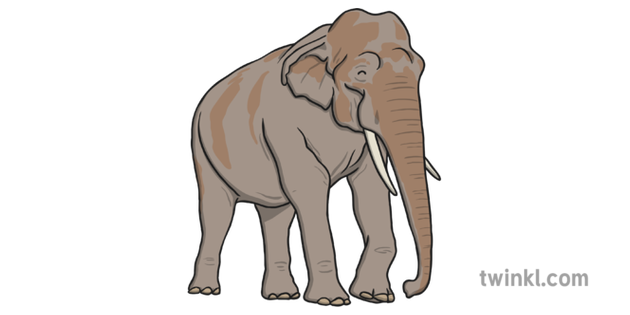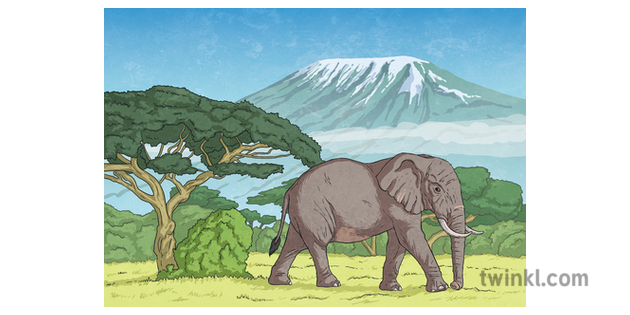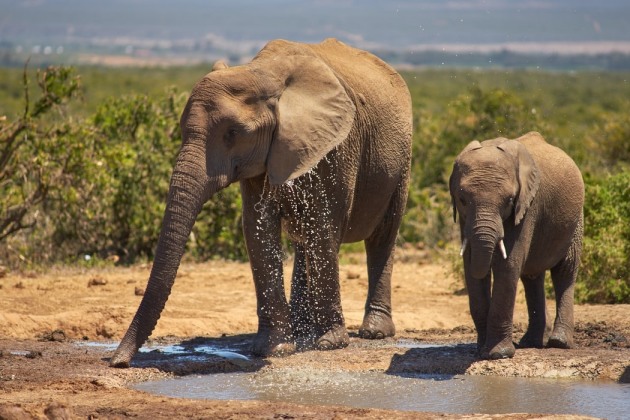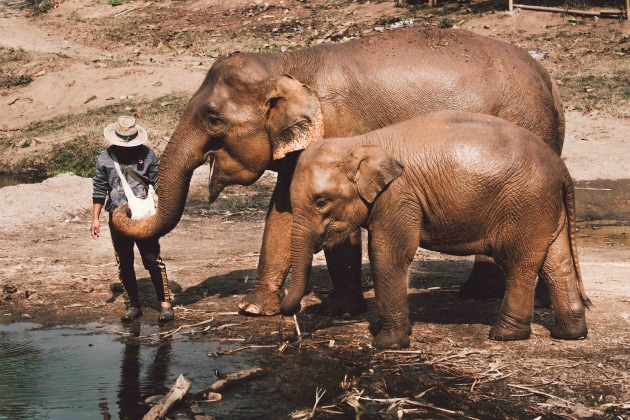


Elephants are indigenous to Africa and Southern Asia, and they're identifiable by their exceptionally large size, long trunks, four columnar legs and greyish brown colouring, as well as their long curved ivory tusks. They're a relative of the extinct mammoth.
There are some physical differences between the African and Asian elephant too. The Africa elephant has much larger ears, and the Asian elephant has a twin-domed head with an indent in the middle, whereas the African elephant has a singular dome.
They're exceptionally large herbivore mammals and are the largest living land animal.
At the turn of the 20th century, there were a few million African elephants and about 100,000 Asian elephants. Now, there are an estimated 470,000 African elephants and between 40,000 – 50,000 wild Asian elephants.

Elephants are herbivores and so to survive in their habitat, they need to be able to find shrubs, grasses, bushes and trees to eat. They like to eat banana and sugarcane which are grown by farmers as well.
They also look for areas with rivers, lakes or streams so that they can drink water. If they can't find water sources, they'll use their strong trunks to dig up vegetation and create entirely new watering holes.
Living in different continents, African and Asian elephants have differing habitats.
African elephants live in a wide range of habitats, including wetlands, forest, grassland, savanna and desert across 37 countries in southern, western and Central Africa.
In their habitat, African elephants stamp and dig into dry stream beds to uncover water that's just below the surface. They often work together, using their tusks, trunks, and feet, until they reveal a supply of water that's big enough for everyone in the group to share.
A lesser known third species of elephant also resides in Africa. Forest elephants have adapted to live in the forest habitat of the Congo basin. They're smaller than other African elephants and have adapted to the lush rainforest environment.
The Asian Elephant lives in 13 countries across South, Southeast, and East Asia. This elephant's habitat tends to be in wet forest and grassland with tropical climates, but they also live on plains, in evergreen and semi-evergreen forests, as well as cultivating lands.

Both African and Asian elephants have adapted to their unique habitat.
Asian elephants for example like to live in more tropical climates compared to African elephants. Asian elephants don't actually have any sweat glands, due to this they have to adapt and find other ways to cool down, which include flapping their ears to create a fan effect, or spraying water from their trunks.
African elephants have also had to deal with their surrounding habitats and areas becoming more populated with people. To deal with this they use their tusks to warn, protect and defend themselves against poachers or if they feel threatened.
Humans have also started to adapt better, as conservationists have helped farms protect their crops to help keep the distance between humans and elephants.
Did you know that the African Elephant is the largest land animal on earth? Making them larger than their Asian cousins and can be identified with their larger ears.
African elephants have much larger ears than the Asian elephant. This is so that it's able to dissipate its body heat in the high temperature of the African savanna. In hot weather, elephants can even increase the blood supply to their ears and they flap them around to dispel body heat.
Having wrinkly skin is another way that African elephants stay cool in the heat. It allows heat to escape their bodies and when they take a dip into water to cool off, the wrinkles trap the water, which means that they can stay cooler for a longer amount of time.
Did you know that an elephants' trunk is used the same way as a nose? It's used for smelling, drinking and grabbing - making it very versatile!
An elephants' trunk is pretty powerful as it boasts 40,000 muscles.
Did you know that African elephants have two finger-like tools at the end of their trunk to help them with grabbing things? Asian elephants only have one.
Both male and female African elephants have tusks they continuously grow and are used to help dig for food and water and stripping bark from trees.
An African elephants' habitat is usually in savannas, located in Sub Saharan Africa. Although elephants can also habitat in rainforests, primarily in Central and West Africa. Due to the two differences in habitats, African elephants can be split up into two - forest elephants and savanna elephants, although some scientists argue there aren’t any physical or genetic differences between the two.
African elephants play a big part in their habitat and are referred to as ecosystem engineers. This means they shape their own habitat helping them survive, as well as other animals too. For example, during the dry season, African elephants use their trunks to dig up riverbeds, this later creates watering wholes in which many animals go for water.
Another useful part African elephants play is with their dung! It's full of seeds - a great way to help spread plants across their habitat and the environment. An African elephants dung also provides a good habitat for dung beetles too! That's not everything, these clever animals also create passageways for smaller animals in the forest as they snack on trees.
An African elephant adapts well to its habitat and forages for food that is easily accessible, including roots, grasses, fruit and bark.
Did you know that an adult African elephant can eat up to 300 pounds of food per day?
African elephants don't tend to sleep much, they spend most of their day roaming great distances foraging for food to maintain their large bodies.
The biggest threat to African elephants is poachers as they're hunted for ivory found in their tusks. The threat increased when Europeans colonised the area, this kicked off the illegal trade. Ivory from the tusks would be used for piano keys, combs and many other items.
Prior to 1970, the elephant numbers were said to be around 26 million. As we reached 1970 the numbers dropped dramatically to 1.3 million. Today it's believed that there are roughly only around 400,000 African elephants remaining in the wild.
Due to the threat and the increasing demand for ivory, African Elephants are evolving and becoming tuskless.
African elephants are protected in their habitats and geographical locations. They're protected under international environment agreements, CITES and the conservation of Migratory Species.
There have been efforts to try and re-legalise the trade of ivory but so far these efforts have been unsuccessful.
Conservation groups have worked on created pathways to connect elephants to protected land. It's believed that 70% of elephants currently habitat in unprotected land.
Since the Asian elephant's ears are much smaller than the African elephant's, they have had to adapt another way to cool themselves off. They primarily flap their ears to fan themselves and dissipate body heat.
Asian elephants can go through six sets of teeth in their lifetime. This is because their diet (made up of plants) means they're constantly chewing and wearing their teeth down. Having six sets of teeth means the Asian elephants can enjoy their herbivorous diet and make the most of the food available in their forest habitat.
Asian elephants are very adaptable, which means that various settings can be suitable as an Asian elephant habitat, including a thick jungle, savannahs, rainforests, scrub forests, or grassy plains.
Asian elephants live in isolated pockets of India and Southeast Asia. While they are considered forest animals, open, grassy areas with different types of plants and shade from the sun have been found to be a preferred Asian elephant habitat.

An Asian elephant habitat needs enough vegetation and water for the elephants to live off and, if necessary, Asian elephants will migrate to find these habitats. They tend to move around within their home ranges, which might take up an area from sizes of 15 to 800 square kilometres.
This migration has been affected by human activities, like agriculture, which can also affect an Asian elephant’s habitat.
Though they live in different habitats and different parts of the world, both species of elephant have evolved tusks and trunks. Here's how they're useful in each elephant's habitat:
Evolved from teeth, elephant tusks have lots of advantages and they're a way that elephants have adapted to their habitat. They can use their tusks to lift objects, gather food, strip bark from trees, and also dig into the ground to find water. They also use their tusks in defence when threatened. All African elephants have tusks, whereas only some male Asian elephants have tusks, with female Asian elephants not having any at all.
Elephants use their trunks in a number of different ways. One of the main ways that they're used is to pluck leaves and vegetation off trees for the elephants to eat. They also use them to lift up water and drink it or spray it over themselves to stay cool. They even spray dirt onto themselves using their trunk, and the dirt acts as sun cream, so that they don't get sunburnt. The trunks are also strong enough to lift and move large objects, such as tree trunks.

The elephant's habitat is one of the main reasons why this animal is endangered. Habitat loss is one of the key threats it faces.
If climate change continues, the elephant's habitat will become much drier and hotter, which will make it much more difficult for vegetation to grow. This means that the elephants won't have a reliable source of food, and it'll be harder for their young to survive.
Humans are also encroaching on the elephant's habitat to hunt for their ivory tusks.
The rapid growth of the human population in Africa and the fact that most African elephant habitats remain outside protected areas means that the size of the African elephant's habitat is on the decline. As humans continue to populate these areas, more and more of the land is stripped for agriculture or for homes. Known as habitat destruction and habitat fragmentation, this shrinks the elephant's habitat further.
Conflict between elephants and humans is another factor. Elephants turn to the farmers' crops and fields for food because their habitat and usual source of food has been disrupted, and as a result, elephants are killed or hunted in retaliation.
Asian elephants also face the risk of habitat destruction and loss. Human populations are growing fast in the Asian elephant's habit as well, which leads to the elephant population becoming small, isolated, and cut off from their ancient migratory routes because of human settlements.
More and more dams, roads, mines and other industrial complexes are built in the elephant's habitat, which means the larger habitat has been split into smaller fragments.
Work is being doing to conserve the habitat of both African and Asian elephants. There are even conservation programmes which work with farmers to help them protect their crops from hungry elephants and provide them with compensation if an elephant does raid their crops.
The Asian Rhinos and Elephants Action Strategy (AREAS) is also to aiming to help remaining Asian elephant populations by improving the connections between their fragmented habitats.
The main goal of elephant habitat conservation is to protect the habitat that the habitats have left and to help elephants and humans to live alongside each other peacefully.

Poachers are a big threat to both African and Asian elephants because they're hunted and killed for their tusks due to the demand for ivory.
This is an illegal trade and there is regulation in place to stop this, called the Convention on International Trade in Endangered Species of Wild Fauna and Flora (CITES). It's a global agreement set by the government to protect endangered animals from illegal trade.
On January 1, 2018, China made banned domestic trade of elephant ivory, which was a big move as China was the largest market.
Why do elephants not use a computer? ... Because they're scared of the mouse!
There are lots of crazy things we have been told or think we know about elephants, but are all of these true? Let's find out.
1. Elephants drink through their trunks.
An elephant's trunk is an extremely useful and versatile limb for elephants which they use for drinking, breathing, eating, smelling and communicating. Although they do use their trunks to drink, the water won’t go all the way up. Instead, they’ll suck the water partway up the trunk and pour it into their mouths — a lot. Elephants drink between 140 and 230 litres a day on average.
2. An elephant never forgets.
Elephants are amazing creatures with both impressive physical statures and emotional capacity but are the old phrase that 'an elephant never forgets' really true? Although it may be a slight exaggeration, it may be more true than you would expect.
Elephants definitely have very large brains, which may increase their memory capacity and aid their complex patterns of communication. It is not easy to measure with precision the memory span of an elephant.
3. Elephants are scared of mice.
We are all familiar with this one, from the film 'Dumbo' to every elephant featured in our favourite Saturday morning cartoons, we are told that one thing about elephants — they are scared of mice. Well, there is very little proof that this one is true but it is believed that the elephant's fear of mice has more to do with the element of surprise than the mouse itself.
Theories that elephants are afraid of mice largely suggest it is because they are tiny creatures that are able to nibble on their feet or can climb up into their trunks but there is no evidence to prove this particular theory. This theory seems to date back centuries to the Ancient Greeks, who reportedly told fables about a mouse that climbed into an elephant's trunk and drove it crazy.
4. Elephants can drink through their trunks like a straw.
An elephant's trunk is an incredibly versatile limb, used for breathing, smelling, touching, grasping, and producing sound, and it is very true that elephant's use their trunk's to drink, but the water won’t go all the way up. Instead, they’ll suck the water partway up the trunk and pour it into their mouths — a lot. Elephants drink between 140 and 230 litres a day on average.
Why not introduce Elephants to your class with some of our fantastic elephant resources and elephant templates?
Elephants are known for being the largest land-based mammals to live on Earth, so they'll make a fascinating topic for your pupils of all ages.
You can use our many elephants themed resources and activities to teach your class about elephants in an interesting and engaging way whilst developing key skills that form the foundation of all of their future learning.
As a start, why not break out this reading comprehension activity with your KS1 class?It's a great way for children to learn lots of fascinating facts about elephants while improving their reading skills at the same time. This resource also includes photos and illustrations to help with visual learning.
This is a fantastic resource to teach your class about cultural and religious diversity with a fun elephant theme. Children can learn about the religious festival of Diwali while learning to identify the key features of elephants. They can also get creative when decorating their very own Diwali inspired craft with this elephant template.
A great way to start a new topic! Check out this fantastic teacher-made PowerPoint to teach children all about the African Elephant. It covers what they look like and how they behave, including how they use their famous trunk.
Once your class have engaged with learning all about the amazing creatures that elephants are, use this elephant themed template to inspire their own independent and creative writing skills.
These collage elephant templates are a great way to create a vibrant learning environment. Get students to complete these collage templates then hang them around the classroom to engage them with the elephant theme.